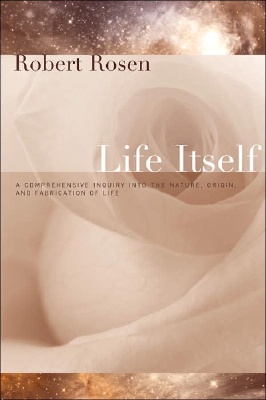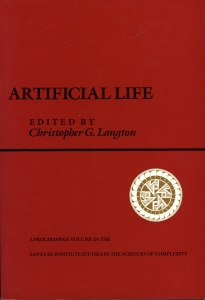
This summer I spent most of my reading time on this book: “Life Itself, A Comprehensive Inquiry Into the Nature, Origin and Fabrication of Life”, by Robert Rosen.
It is an amazing book, of quite incredible scope. The book steadily builds up one very clear and coherent argument that requires many step-by-step preparations in the areas such as physics, mathematics, biology and epistemology. The best description of its form is given by the author in his introduction: “This book, like most books, has a primary structure and a tertiary structure. The primary structure is, of course, the linear string of symbols, words, paragraphs and chapters that is mandated by the nature of the language. But just as with a molecule of globular protein, which must fold in order to become active, this linear string must be folded back on itself, so as to bring parts remote on the string in close contact. This particular volume is very heavily folded indeed.”
Because the argumentation consists of many steps, the treatment of each of them is quite sparse, the emphasis throughout the book being on the mathematics and formal models which express the argument most succinctly. For a non-specialist like me that makes the book at times a pretty tough read since it is easy to lose the thread by missing a link; I certainly would have appreciated some more lush greenery in the form of examples and redundant explanations. But there is a companion volume to the book, currently near the top of my reading pile, called “Essays on Life itself“, which is devoted precisely to developing some of the tangents to the main book. And the winding argumentation of Rosen touches on many interesting areas indeed, inhabited by the ghosts of the likes of Newton, Gödel, Church and Turing. Also it has a short elucidation of the remarkable work of master ghost and inspirator Nicholas Rashevsky, who apparently already talked about things like neural networks, self-organization and reaction-diffusion mechanisms in the thirties, about twenty to thirty years before computers entered the scene and people who are now much more famous became involved in these subjects. Certainly somebody to investigate.
The publisher’s blurb sums up much better than I could what the book tries to achieve:
“What is life? This is perhaps the most provocative and significant question our minds can address. It provides the soul and central impetus to the science of biology, which studies life through the example of living organisms.
How we answer this question, and how we seek an answer, crucially influences every aspect of human thought and human action. For four centuries, it has been believed that the only possible scientific approach to this question proceeds from the Cartesian metaphor -organism as machine. Therefore, organisms are to be studied and characterized the same way “machines” are; the same way any inorganic system is. This strategy, derived from Newtonian mechanism, is embodied in reductionism: break what is complicated into simpler pieces, understand the pieces themselves, and reconstruct organisms from this understanding.
In Life Itself, Robert Rosen argues that such a view is neither necessary nor sufficient to answer the question. He asserts that life is not a specialization of mechanism, but rather a sweeping generalization of it. Above all, Rosen argues that renouncing mechanism does not mean abandoning science. A radical alternative is proposed, drawn equally from experience in biology, physics, and mathematics; an alternative which draws attention to a new class of complex systems, which are radically different from mechanism.”
Because of the length and level of interest of the argument being developed, there is this tremendous build-up of suspense throughout the book, and upon reaching the end I couldn’t help but be a bit disappointed. Not quite rightly so, since the claims Rosen makes are quite enormous, but it is more that I apparently fail to understand a few crucial elements in his chain. In particular I don’t understand sometimes what the difference really is with the ‘mainstream’ Artificial Life community. It is never said explicitly in the book, but it does feel a lot of it is directed against a type of approach to life which is the basis of this field.
As a sidenote there is an interesting connection in this sense between Robert Rosen and the physicist Otto Rössler whose work I was reading a couple of months ago: they are both questioning some very basic assumptions firmly held by the scientific mainstream and both seem to have been delegated to the periphery because of that. And both cite Gödel as part of their justification to do so.
When thinking about the questions Rosens book raises, I found it very illuminating to reread Chris Langton’s paper about Artificial Life, published in the proceedings of the first Artificial Life workshop held in Los Alamos in 1987, which is almost a declaration of principles of the field of Artificial Life.

There’s three main points where until now I have failed to comprehend Rosen’s position, which I will point out by comparing it to Christopher Langton’s ideas:
– complexity / fractionability
One of the arguments Rosen develops as to why organisms are not mechanisms is that mechanisms are ‘fractionable’; simply said this means that they can be split in parts and put together from parts. The behaviour of the total machine is the sum of the behaviour of the parts. In contrast to this he argues that organisms have different, more complex, non-fractionable relations between their parts, which makes it impossible to describe them in mechanistic terms.
Langton sees no problem for Artificlal life to be completely mechanistic and reductionist, but he stresses the ‘non-linear’ interactions between parts, which give rise to complex emergent behaviour, which is also more than a simple sum of parts.
So what is the real difference between their positions ?
– simulation
Rosen develops a very interesting argument that it is a big mistake to equate simulation with scientific modelling; according to him simulations are worthless as tools of inquiry. It is one of the parts of his book I found most difficult to follow, but nevertheless very intriguing and I will try reading again in order to get it.
In contrast with this I suppose Artificial Life started as soon as simulations of complex phenomena were possible on a computer. These simulations are more or less the core of Artificial life; their position is that these simulations can develop into alternative, non-carbon-based forms of life which can teach us many things about how living organisms work.
– predictability / useabilty
Partly because his book is so sparse, I don’t really see how one could apply the insights from Rosen’s book. He does not give any examples of an organism he ‘understands’ better with his methods than would be possible with reductionist methods. Here Artificial Life offers a plethora of bits of mechanisms, great graphics and exciting simulations.
Somewhere the Rosen book did strike a deep chord; it reminded me of a quite devastating (and extremely obscure) book I once read: “La Perversion Mathématique, l’oeuil du pouvoir”, by A.A.Upinsky. In it, the author develops a very convincing argument linking the history of mathematics with the history of bureaucratic power. Great stuff, but also quite troubling if you are an abstract artist and most your heroes glorify either the square or the dot. Rosens book has something of the same, uncovering a kind of perversion in the assumptions which also underly generative art, for instance.
Hmmmm.
